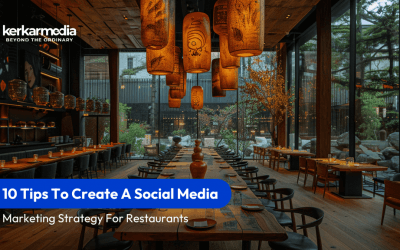Content Marketing Trends for 2023 & Beyond
The marketing world is changing every day. New tools and technologies emerge, fresh thinkers put new spins on old tactics, and the bar for quality continues to rise as audiences everywhere are exposed to more content in a day than they could possibly process. For all the changes that have taken place over the years, one thing is certain: Content marketing is here to stay and prove itself that ‘the Content is the King’. But content marketing trends keep changing very often. In fact, this time last year, it was estimated that the content marketing industry would be worth more than $400 billion by 2021.
The Content Marketing Institute defines Content Marketing as
” Content Marketing is a strategic marketing approach focused on creating and distributing valuable, relevant, and content to attract and retain a clearly-defined audience — and, ultimately, to drive profitable customer action.”
And as content marketing continues to grow and our approaches to it become more mature, these content marketing trends will shape the way companies (and their audiences) create and consume content in 2021
1. Content Marketing Is Becoming Marketing.
In the midst of the daily grind, it’s easy to forget that content marketing as we know it is still a relatively new phenomenon. As recently as a few years ago, marketers handled content mostly as a side project. It was more of a bonus than an essential role — something you did when you had time because it took a backseat to more traditional marketing projects and responsibilities.
That’s changed. Where marketing of the past used to push one-sided conversations toward consumers, successful brands know that content marketing opens the door for two-way conversations and relationships with audiences unlike anything before.
Content marketing has taken over because it’s so useful to every function of marketing teams today. Content is one of the best tools you have for earning trust, building your brand, generating site traffic and qualified leads, and everything in between. Content marketing is marketing, and the brands that understand the content is core to effective marketing — and, ultimately, to their entire business — will set themselves up for success.
2. The Strategy Will Become More Essential.
As content marketing matures, companies will begin to see their content less as a catchall solution and more of a tool to achieve their specific goals. Content is incredibly powerful, but it won’t solve every business goal you set on its own. These tactics need a guiding strategy to maximize their effectiveness and secure audience engagement.
Different companies have different goals, so no two content strategies work quite the same way. Still, general goals like lead generation, SEO, and thought leadership is common, and starting from there, companies can customize strategies that are specifically designed to work toward whichever goal is most important to them. With sales trends always changing, content plays a key role in attracting new customers.
According to Content Marketing Institute, 65 percent of the most successful content marketers have a documented strategy. A simple content marketing assessment can help companies identify their primary goal and design a successful content strategy to meet them. As strategy becomes more important, companies will need the right tools to align priorities and document their plans.
3. Customer Success Will Emerge as The New Frontier.
Content marketing already addresses a variety of needs and objectives for different departments. Sales teams use content to bolster pitches and improve client relationships. Brand managers turn content into goodwill and authority. Recruiters attract top talent by publishing content in places where the best candidates spend their time online. The possibilities are endless — and now, a new avenue is opening up.
Customer success refers to the ways companies help customers get the most value from products and services. In this era of personalization, it’s no longer enough to make the sale, move on to the next one, and handle complaints as they arise. Now, companies need customers to get maximum value from their purchases to encourage word-of-mouth marketing and develop stronger relationships.
In this pursuit, content helps companies equip their customers for success. The content shows buyers’ optimal uses for companies’ products and services, encouraging customers to see the good more than the bad. With a content strategy focused on customer success, businesses can devote fewer resources to putting out fires and more resources to growing their brands.
4. The Marketing Funnel Will Change Shape.
Right now, the marketing funnel as we know it accepts just about anyone and everyone filters them through qualification processes, then spits them out at the end without much of a parting word. Too many companies see customers as gatekeepers to wallets; meanwhile, customers feel ignored at best — and insulted at worst — when the journey ends.
A change in mindset and a library of high-quality content will replace this traditional funnel with something more sustainable (and effective). The funnel is becoming more of an ongoing cycle that prioritizes continuous engagement over transactional relationships. This increased focus on nurturing, especially post-sale, makes customers more likely to stay with you or buy again — and more likely to give recommendations to friends and colleagues.
With content, you can transition your brand from vendor to partner. To be honest, someone else in your space can almost always come in and undercut you on price. But when you continuously engage your clients, build lasting trust, and form genuine partnerships, you’ll have much greater staying power.
5. Distribution Will Remain a Driver of Success.
Even the best content is useless if no one sees it. As both offline and online worlds become more crowded, content distribution will remain a vital component of every good content marketing strategy.
Staying updated on social media marketing trends is great, but social is just the tip of the distribution iceberg. You need to stay updated with all the content marketing trends. Email marketing helps; still, brands need to dig deeper to discover the distribution channels unique to their audiences. Could you include physical copies of content with certain products? Maybe sales and marketing can work together to target specific accounts and get relevant materials directly into their hands? Or maybe a speaking engagement is the best way to share your message with your audience?
Companies need to get creative and enthusiastic about getting their content in front of the right people. Passive distribution — or, worse, the distribution you do as an afterthought once you realize no one is engaging with your content — won’t cut it. Don’t let your investment in content go to waste by sitting on some of your most valuable marketing assets.
The next year promises more of the same: a continued takeover by content marketing. As brands keep refining their strategies as per latest digital marketing trends, lukewarm content approaches will no longer suffice. Companies must adapt or fade into irrelevance, and the way marketers see and respond to content marketing trends like these will determine the fate of their organizations.
6. Authenticity, Transparency, and Value Marketing
When it comes to any type of marketing, authenticity, transparency, and value have always important.
(Or, at least, they should have been.)
However, by 2021, all of this will essentially be table stakes. That is, if your content doesn’t accurately reflect your brand’s voice, the mission your company stands for, and the value you hope to bring your target audience…well…you might as well not create it in the first place.
Case in point:
- 86% of consumers say that authenticity is a key differentiator that leads to a purchasing decision
- 73% of consumers would pay more for a product if the company behind it promises transparency
- 94% of consumers say they would remain loyal to a brand that provides complete transparency
Needless to say, companies that don’t provide this transparency – and perhaps even go as far as to create inauthentic content – are going to suffer moving forward.
For one, not being transparent in the first place is typically seen by consumers as a red flag of sorts. Moreover, those who notice said red flags are probably going to dig deeper into said company’s statements to determine their validity; any discrepancy between what a company says and what it actually does, of course, is going to cause major problems among its audience.
With regard to providing value through the content you create, the purpose of content marketing has never been simply to sell your products or promote your brand. Rather, content marketing has always been about providing value to your audience in some way – be it educating them, entertaining them, or otherwise. In doing so, you communicate a sense of authenticity and transparency through your content, in turn allowing your customers to trust your brand moving forward.
7. Content Personalization and Interactivity
Most customers today are using our platform to personalize their e-Commerce customer experiences — and we expect to see more content personalization taking place across the e-Commerce industry and beyond in 2021. That’s because:
- 78% of consumers say that personally-relevant content is a determining factor in their purchasing decision
- Increasing personalization can lead to a 500% increase in consumer spending
- A lack of relevance leads to an 83% decrease in engagement rates
Furthermore, content that provides even the slightest bit of interactivity, according to Jeff Bullas:
- Enables brands to differentiate themselves from their competitors
- Leads to enhanced engagement among their target audience
- Fosters an increased sense of trust and credibility among their viewers/readers
That said, as we move into 2021 with updated content marketing trends you’re going to want to figure out numerous ways in which to create personalized content that allows – and in some cases requires – your audience to interact with your brand.
8. Cross-Team Input and Development
Going along with what we said earlier about authenticity and transparency, the process of content creation should span throughout your entire organization – not just your marketing team.
That is, everyone in your organization – from the CEO to your ground-level employees – should have some input at some point in the content creation process. There are a number of reasons for making this change.
For one thing, each of your team members engages with your brand’s customers in different ways – and will be able to provide varying perspectives regarding their needs and expectations in terms of the content they want to see. Similarly, as each team member plays a different part in the overall operations of your company, they have their own unique understanding of the value your company provides. Putting these two points together, your various team members will likely have a number of different ideas as to how to communicate your value to your audience members. This is one of those content marketing trends that you should definitely leverage in 2021.
9. More Collaboration Between Brands
More and more, we’re seeing multiple brands work together to create the content of all different varieties.
A prime example of such collaborative content is Red Bull and GoPro’s “Stratos” project, in which the companies presented Felix Baumgartner’s 24-mile plunge from a space pod down to Earth.
Ride-hailing company Uber has also delved into the creation of collaborative content, partnering with both Pandora and Spotify to help personalize its customers’ ride via their favorite music.
Other examples of collaborative content include:
- Podcast interviews (in which hosts of different shows trade-off interviewing one another on their respective channels)
- Collaborative research or case studies
- Social media “takeovers”
When brands create content together, said content can be housed on both companies’ channels (as is the case with Uber and Pandora), or on a single channel cooperatively created by both brands.
10. Integrations as A Growth Lever
Similarly, to what we just discussed, more and more SaaS companies are beginning to see their partnerships with other service providers as an opportunity to create a ton of content for the end-user to devour.
As explained, while partnering with other SaaS companies to create integrations clearly allows both parties to enhance the services they provide their customers, the “real impact (on growth) comes from picking the right partners and focusing on strategic co-marketing efforts.”
11. Using Influencers as An Ad Hoc Content Team
While the buzz around influencer marketing certainly continues to grow, it’s also worth noting that many brands have begun implementing a sort of reverse approach to the marketing tactic.
That is, instead of partnering with influencers to have them promote your brand on their channels, you can invite them to create content to be displayed on your own. This is one of those content marketing trends that is going to flourish more and more for years to come.
Having an influencer create content on your own channel certainly adds some credibility to your brand in the eyes of your followers. Secondly, the creator of the content is likely to share it with their audience, as well – equating to some massive visibility for your brand.
12. Developing Multimedia Content with Omni-Channel Distribution
As we’ve alluded to a few times throughout this article already, multimedia content is quickly becoming less of a “nice to have” – and more of a necessity.
Regarding the consumption of video content.
- 75 million US consumers watch video content on a daily basis
- By 2021, video traffic is expected to account for 80% of all consumer internet traffic
- Video content that’s around two minutes in length generates the highest levels of engagement
While consumption of audio content isn’t nearly as huge, it’s certainly growing as a content marketing trends over the past few years. Roughly one-quarter of Americans listen to podcasts on a monthly basis, with one-third of Americans age 25-54 doing so. Additionally, 6 million more Americans reported listening to podcasts on a weekly basis in 2018 than did so in 2017; of those that do, 40% of them listen to more than one show.
Regarding the effectiveness of omnichannel marketing:
- 98% of consumers use more than one device over the course of a given day
- Companies that utilize omnichannel strategies report a 91% year-over-year increase in retention rate over those that do not.
- 87% of consumers believe brands should be putting more effort into their omnichannel initiatives.
13. Use of Content Cluster
First of all, longer-form content (e.g., articles over 1,000 words in length) inherently caters to the most passionate of your followers – that is, those who are most likely to become brand loyalists and evangelists. It’s simple: the more interested an individual is in your niche, the more they’re going to want to learn about it.
On a more logistical level, Google’s more recent algorithms tend to recognize longer-form content as being more valuable – making such content more likely to rank higher in search results.
(This, of course, is assuming the content is high in quality in the first place.)
Additionally, Google’s algorithms now place high importance on topic clusters – that is, multiple pieces of long-form, valuable content revolving around a single topic. In creating content clusters, you essentially prove to Google that you’re not looking to game the system by creating one or two pieces of keyword-stuffed content – you’re actually dedicated to providing your audience with highly-valuable information regarding the topic at hand.
This brings us to the end of the list of content marketing trends that will shape digital marketing strategy in 2021. If you want to stay ahead of your competition, create an effective digital marketing strategy after taking into consideration the current and upcoming content marketing trends then we as the best digital marketing company in Mumbai would look to take your brand a notch higher with our digital marketing efforts.











